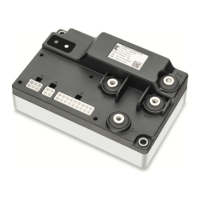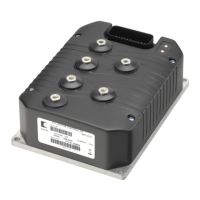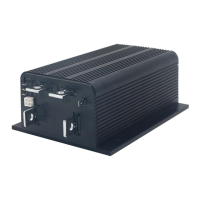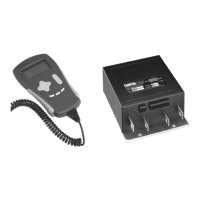INSTALLATION AND WIRING Page: 7 Mounting the Controller Details physical mounting requirements and considerations for the controller for optimal performance and environmental protection.
High Current Connections Explains the proper wiring procedures for high current terminals (B+, B-, U, V, W) on the controller.
Low Current Connections Details the wiring procedures for low current signals and I/O through the 35-pin AMPSEAL connector.
Switch Input Wiring Describes the dedicated functions of various switch inputs and their parameter settings for system control.
Throttle Wiring Explains how to connect and configure different types of throttle inputs (potentiometers, voltage sources) for vehicle control.
Digital Input Specifications Lists digital input specifications including thresholds, impedance, voltage range, and ESD tolerance for various inputs.
Analog Inputs Describes the two generic analog inputs and their VCL interfacing capabilities, often used for temperature sensors.
Analog Output Specifications Details specifications for the analog output, noting its availability on specific models and its driver output characteristics.
Power Supply Outputs Describes the auxiliary power outputs (+12V, +5V) provided by the controller for low power circuits.
KSI and Coil Return Explains the function of KSI input for power and battery sensing, and Coil Return for contactor wiring.
Throttle and Brake Inputs Covers the two potentiometer inputs used for throttle and brake, and their alternative uses as analog signals.
Communications Ports Details the CAN and serial ports for controller communication, programming, and diagnostics.
PROGRAMMABLE PARAMETERS Page: 29 Programming Menus Organizes programmable parameters into hierarchical menus for easy access and customization of vehicle performance.
Motor Response Tuning Explains tuning motor response characteristics via speed or torque control modes, depending on application needs.
Control Mode Select Parameter to select between Speed Mode Express, Speed Mode, and Torque Mode for motor response control.
Speed Mode Express Menu Details parameters for Speed Mode Express, a simplified speed control mode for various vehicle applications.
Speed Mode Menu Lists parameters for Speed Mode, offering detailed speed control for various applications and fine-tuning.
Velocity Feedforward Menu Parameters for improving throttle responsiveness and speed control at low speeds via velocity feedforward.
Response Menu Parameters that define how the vehicle responds to throttle changes in speed control, affecting accel and decel rates.
Fine Tuning Menu Parameters for fine-tuning motor response characteristics in speed control mode, adjusting rates and thresholds.
Restraint Menu Parameters controlling vehicle behavior on slopes to limit roll-forward/back speed, enhancing safety.
Position Hold Menu Parameters for engaging and managing the Position Hold mode for vehicle stability on inclines and during stops.
Pump Parameters Parameters for controlling pump motor operation, including enable and reverse direction settings.
Speed Limiter Menu Parameters to limit the motor's speed in Torque Mode, controlling maximum RPM and ensuring safe operation.
Response Menu (Torque Mode) Parameters defining vehicle response to throttle and brake inputs in Torque Mode, affecting accel, decel, and release rates.
Fine Tuning Menu (Torque Mode) Parameters for fine-tuning motor response and behavior in Torque Mode, adjusting creep, gear soften, and reversal settings.
Current Limits Menu Parameters to set various current limits (drive, regen, brake) as a percentage of rated current for motor and controller protection.
Power Limiting Map Menu Defines drive current limit percentages applied at different speeds to manage motor heating and ensure consistent power.
Drive Limiting Map Menu Defines drive current limit percentages applied at different speeds to manage motor heating and ensure consistent power.
Regen Limiting Map Menu Defines regen current limit percentages applied at different speeds to manage torque characteristics and compensate for motor behavior.
Throttle Menu Parameters for configuring various throttle input types and adjustments, including deadband, map, max, and offset settings.
Brake Menu Parameters for configuring various brake input types and adjustments, including deadband, map, max, and offset settings.
EM Brake Control Menu Parameters for controlling the Electric Motor brake behavior, including pull-in voltage, holding voltage, and fault actions.
Drivers Menu Contains sub-menus for configuring individual controller drivers and related functions, including contactors and outputs.
Main Contactor Menu Parameters for controlling the main contactor's operation, including enable, interlock, voltage settings, and fault checks.
Proportional Driver Menu Parameters for configuring the Proportional Driver for valve control, including current limits, dither, and PI gains.
Driver 3 Menu Specific parameters for controlling Driver 3, often used for hydraulic pump contactors, including voltage and enable settings.
Motor Menu Contains parameters for motor setup, tuning, and control algorithms, including motor technology and feedback type.
Battery Menu Parameters for setting battery voltage, over/undervoltage protection, and Battery Discharge Indicator (BDI) algorithm.
Vehicle Menu Settings related to vehicle dynamics, units, and speed/distance capture for performance monitoring.
Emergency Reverse Menu Parameters for configuring the emergency reverse function, including activation source, speed limits, and timing.
Interlock Braking Menu Parameters for controlling interlock braking functionality, managing vehicle deceleration upon interlock signal removal.
CAN Interface Menu Configuration parameters for CAN communication, including Node IDs, baud rates, heartbeat, and PDO timeout settings.
Reset Controller Parameter Allows resetting the controller to default parameters or performing a full controller reset via software.
MONITOR MENU Page: 72 Inputs Menu Displays real-time values for all controller inputs, including throttle, brake, switches, and sensors, aiding diagnostics.
Outputs Menu Displays real-time values for all controller outputs, including PWM, digital, and analog signals, for monitoring driver status.
Battery Menu Displays real-time battery status, including BDI, capacitor voltage, and keyswitch voltage, for operational monitoring.
Motor Menu Displays real-time motor status, including RPM, speed limits, temperature, and encoder feedback, for performance analysis.
Controller Menu Displays real-time controller status, including current, state, errors, and timers, for diagnostic purposes.
Vehicle Menu Displays real-time vehicle operational data like speed, odometer, acceleration, and distances, for performance tracking.
CAN Status Menu Displays real-time CAN communication status, including Node IDs, NMT states, and PDO mapping, for network diagnostics.
INITIAL SETUP Page: 91 Before You Start Outlines essential prerequisites and motor data determination before proceeding with initial setup procedures.
Current Limits Configuration Details the setup of drive, regen, brake, EMR, and interlock current limit parameters for optimal performance and protection.
Battery Voltage Configuration Instructions for setting the nominal battery pack voltage for accurate system operation and protection threshold calculations.
Main Contactor Setup Covers the configuration of parameters related to the main contactor's operation, including enable, interlock, and voltage settings.
EM Brake Setup Guides the setup of parameters for the Electric Motor brake control, ensuring proper engagement and release.
Throttle Input Setup Procedures for configuring the throttle input, including type selection, deadband, and mapping for accurate vehicle control.
Brake Input Setup Procedures for configuring the brake input, including type selection, deadband, and mapping for effective vehicle control.
Faults Check and Clearing Instructions for checking and clearing controller faults before proceeding with setup to ensure a clean system state.
Setting Feedback Direction Verifies and sets the motor encoder's direction of rotation for correct forward/reverse operation and emergency reverse functionality.
Motor Characterization Procedures for characterizing ACIM or SPM motors to optimize controller performance and efficiency.
Emergency Reverse Setup Configures the parameters for the emergency reverse function, enabling safe operation in specific scenarios.
Interlock Braking Setup Configures the parameters for interlock braking functionality, managing vehicle deceleration upon interlock signal removal.
VEHICLE CONTROL LANGUAGE (VCL) Page: 110 Summary of VCL Basics Provides a brief overview of VCL syntax, variable types, and basic programming concepts for custom vehicle control.
Variable Types Explains the different types of VCL variables (RAM, EEPROM) used for storing custom data and parameters.
Potentiometer Inputs Details how VCL can interface with potentiometer inputs for various sensing applications, including throttle and brake.
Throttle Processing Illustrates the throttle signal chain and how VCL can interact with it to create unique throttle commands.
Analog Inputs Describes the two generic analog inputs and their VCL interfacing capabilities, used for sensor data acquisition.
Analog Output Details the analog output function and its VCL interfacing, allowing for external signal generation.
Brake Processing Describes how VCL can process and modify brake commands, enabling custom braking functions based on various inputs.
OEM-defined User Faults Describes how to create and manage OEM-defined custom faults using VCL variables for application-specific error handling.
SETUP_POT_FAULTS() VCL function to set upper/lower fault voltages and replacement values for potentiometer inputs, enhancing fault detection.








